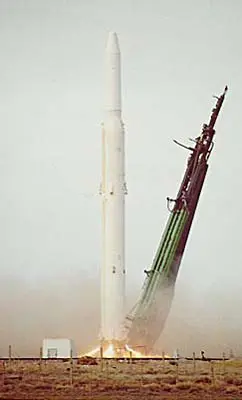IS Mockup
Launch Success
Liftoff Time (GMT)
10:59:00
Saturday November 1, 1969
Mission Details
Launch Notes
Suborbital test flight.
IS Mockup
IS is a family of Soviet military satellites developed in the 1960s with the capability to destroy enemy reconnaissance satellites in low orbit. The program, after being declared operational in 1973, was abandoned in 1993. The IS satellite is a kamikaze-type satellite that carries a conventional explosive charge that it detonates at a short distance from the targeted satellite after carrying out a series of maneuvers to get close to it. The IS satellite has a mass of 2 450 kg and consists of two subassemblies: the first contains the guidance system and a 300 kg explosive charge, the second part contains the propulsion system. The body of the satellite is designed to fragment under the effect of the explosion into 12 groups of shrapnel to ensure the destruction of a target within a radius of 1 km. However, a frontal interception allows destruction only at a distance of 400 meters while an explosion intervening while the satellite catches up with its target allows its destruction at a distance of 2 km. The rocket engine can be reignited a large number of times and is designed to operate cumulatively for 300 seconds. The IS satellite must be placed on the same orbit as the target in order to destroy it. This can be achieved twice a day when the launcher can place the IS satellite on the same orbital plane as its target. Once launched, the satellite is guided by ground controllers to catch up with the target in 1 to 2 orbits. The IS satellite's radar then takes over to provide guidance until the target is only a few tens of meters away. The explosive charge is then triggered, which ejects shrapnel that damages the targeted satellite.
Suborbital
1 Payload
2,450 kilograms
Launch Site
Stats
Tsyklon-2
2nd
Mission
2nd
Mission of 1969
Yuzhmash
445th
Mission
71st
Mission of 1969

